超硬工具チップ は、現代の機械加工および金属加工プロセスにおいて極めて重要なコンポーネントです。超硬チップは、優れた切削性能、長寿命、多用途性を備えており、さまざまな産業用途で欠かせないものとなっています。この包括的なガイドでは、超硬工具チップの種類、用途、材料特性、ニーズに合った超硬工具チップの選び方など、超硬工具チップについて知っておくべきことを掘り下げて説明します。
超硬工具インサートの概要
超硬工具チップは、機械加工で材料の切削、成形、仕上げに使用される交換可能なチップである。炭化タングステン粒子を金属(通常はコバルト)で結合した複合材料である超硬合金で作られています。この組み合わせにより、超硬チップはその有名な硬度と耐久性を実現しています。超硬インサートは、自動車から航空宇宙まで、さまざまな業界の旋盤加工、フライス加工、ドリル加工に使用されています。
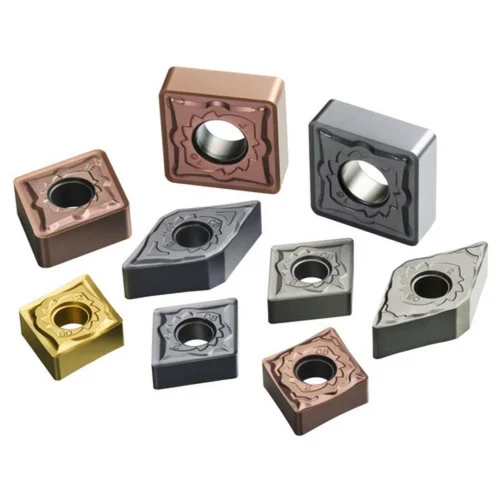
種類 超硬工具インサート
超硬工具チップには、数多くの形状、サイズ、組成があり、それぞれが特定の作業や材料に適しています。以下に、超硬工具チップの種類を表に示します:
| インサート・タイプ | 形状 | 代表的なアプリケーション |
|---|---|---|
| シーエヌエムジー | ダイヤモンド | 一般的な旋削、フェーシング、仕上げ |
| TNMG | トライアングル | 中・重切削、汎用 |
| SNMG | 正方形 | 荒加工、断続切削、ヘビーデューティー用途 |
| ブイエヌエムジー | V字型 | 仕上げ、プロファイリング、高精度アプリケーション |
| WNMG | 六角形 | ミディアムからヘビーの荒加工と断続切断 |
| シーシーエムティー | ダイヤモンド | 軽切削から中切削、高精度、仕上げ加工 |
| ディーシーエムティー | ダイヤモンド | 仕上げと軽い切断 |
| SCMT | 正方形 | ミディアムから荒加工、断続切断、ヘビーデューティ用途まで |
| アールシーエムティー | ラウンド | 軽~中旋削、プロファイリング、高速切削 |
| エーピーケーティー | 長方形 | フライス加工、高送り速度、ヘビーデューティー用途 |
超硬工具インサートの用途
超硬工具チップは汎用性が高いため、幅広い用途に適しています。以下は、超硬工具チップの用途を示す表です:
| 産業 | 申し込み |
|---|---|
| 自動車 | エンジン部品、トランスミッション部品、サスペンション・システム |
| 航空宇宙 | タービンブレード、着陸装置、構造部品 |
| メディカル | 手術器具、インプラント、補綴物 |
| 石油・ガス | ドリルビット、ケーシング、ダウンホールツール |
| 製造業 | 一般機械加工、金型製造、金型製造 |
| エレクトロニクス | 微細加工、プリント基板製造、半導体デバイス |
超硬工具インサートの材料特性
超硬工具チップの材料特性を理解することは、お客様の用途に適した超硬工具チップを選択するために不可欠です。ここに、材料特性の表を示します:
| プロパティ | 説明 |
|---|---|
| 硬度 | 耐摩耗性と耐変形性が高く、通常ロックウェルまたはビッカースで測定される。 |
| タフネス | エネルギーを吸収し、欠けたり割れたりしにくい。 |
| 耐熱性 | 高温下でも硬度と強度を保つ |
| 化学的安定性 | 腐食や被削材との化学反応に強い |
| 熱伝導率 | 切断時に発生する熱を効率的に放熱 |

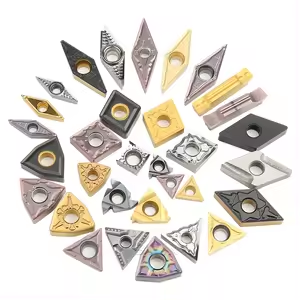
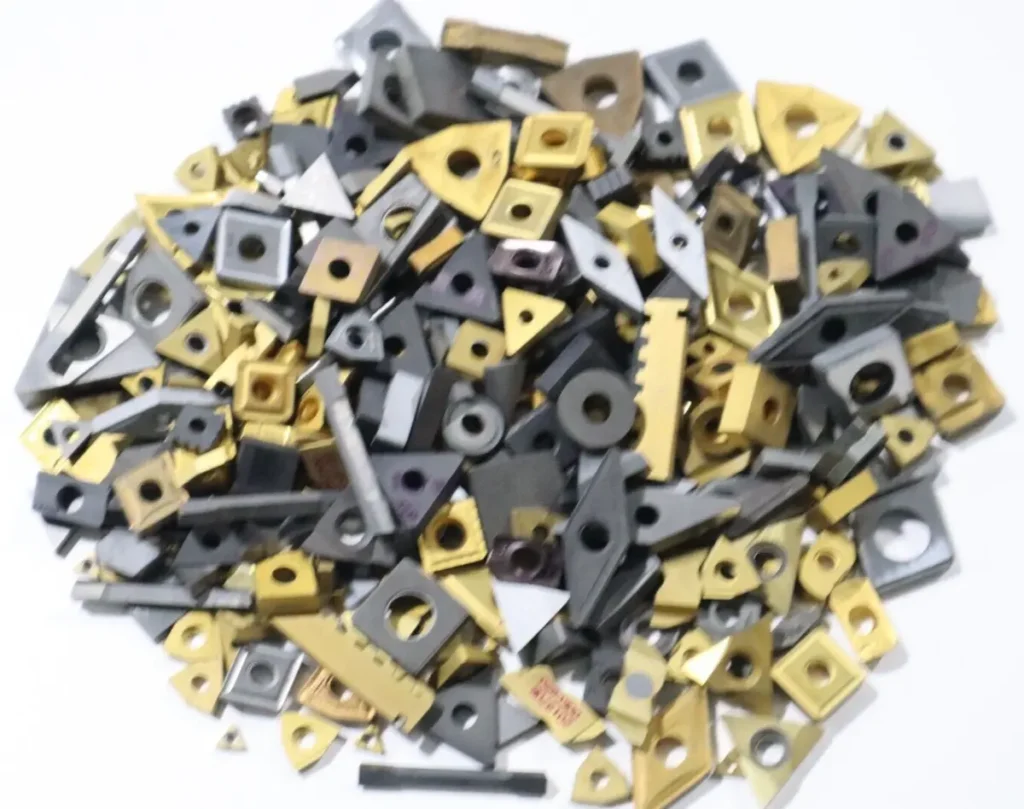
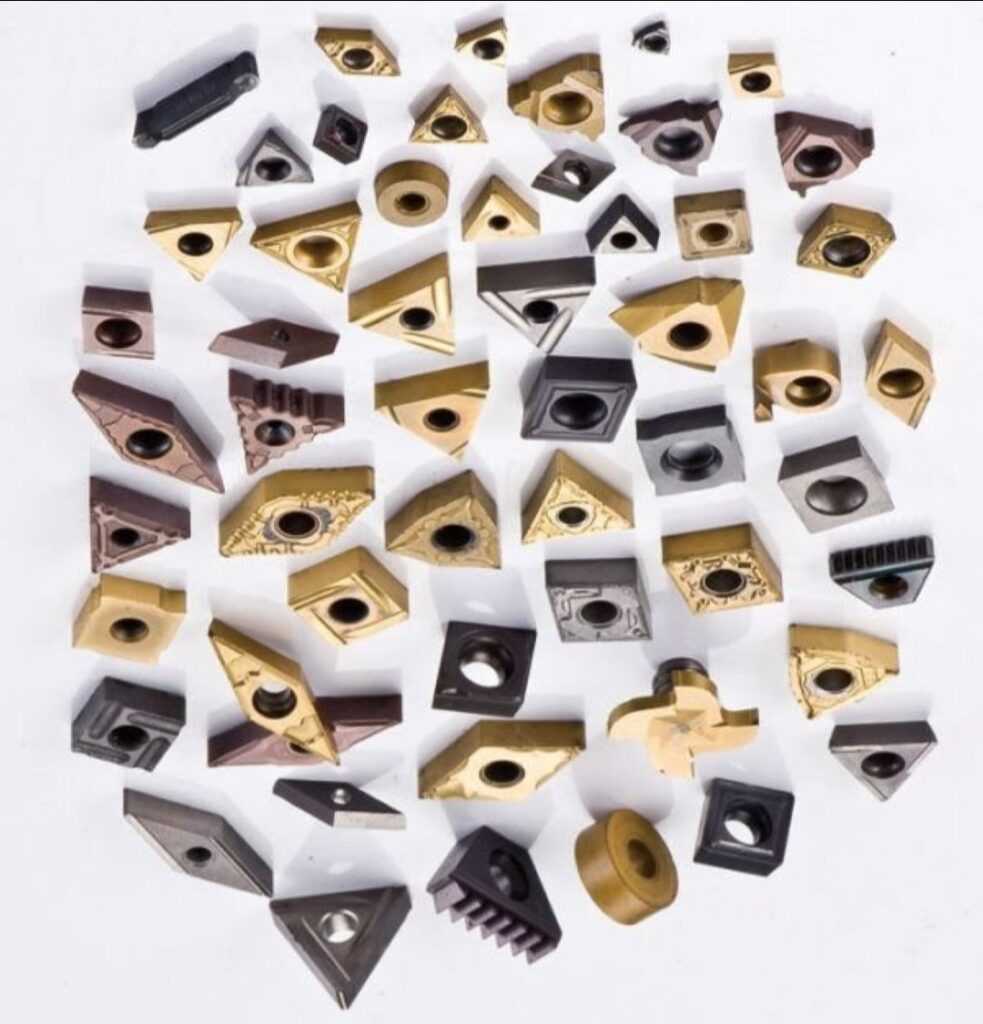
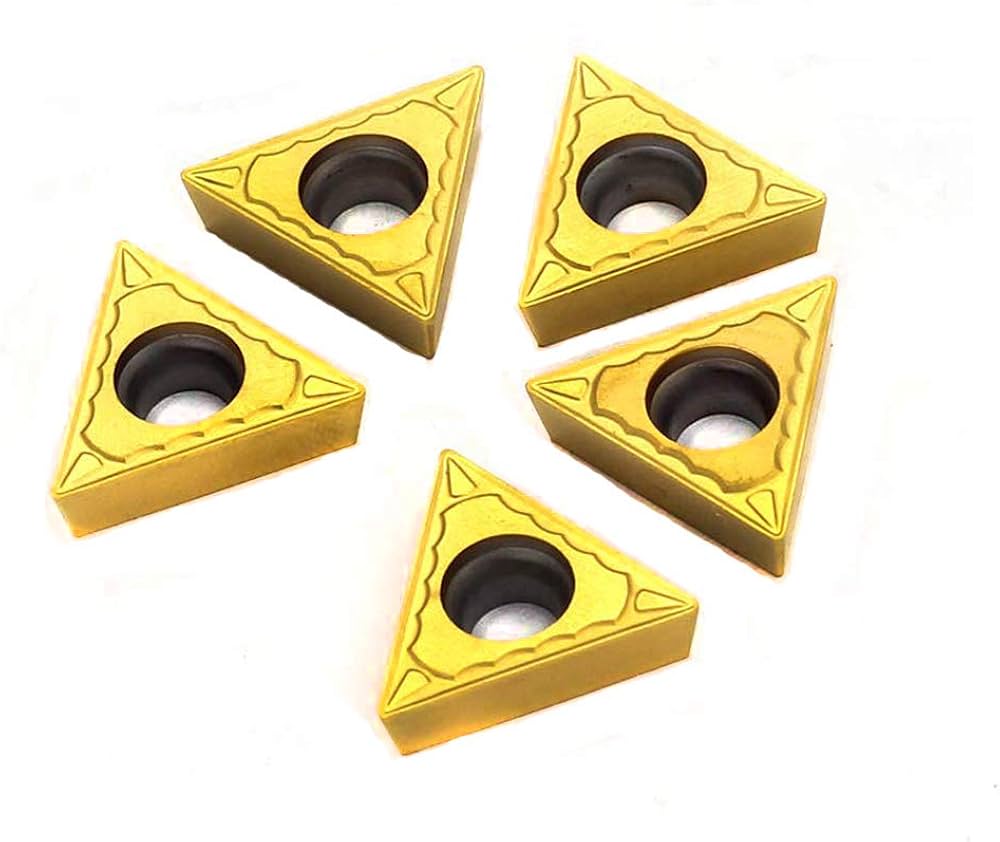
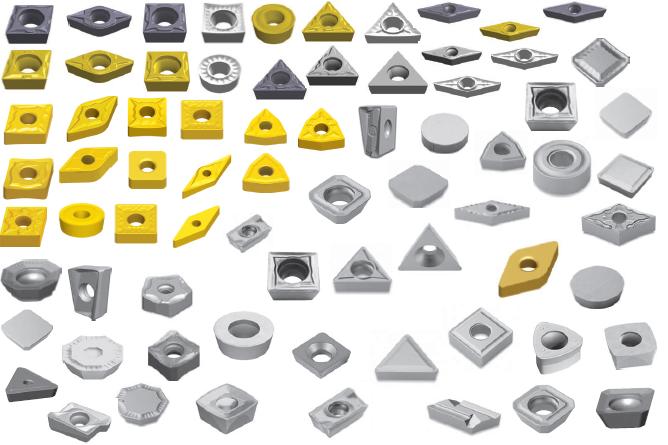
の組成と特徴 超硬工具インサート
超硬工具インサートは、様々なグレードの超硬合金から作られており、それぞれがユニークな特性を持っています。ここに、組成、特性、特徴などを示す表を示します:
| グレード | 構成 | 特徴 |
|---|---|---|
| C1 | 97% WC、3% Co | 高い耐摩耗性、非鉄材料に使用 |
| C2 | 94% WC、6% Co | 汎用性があり、鉄および非鉄材料に適している。 |
| C3 | 90% WC、10% Co | 靭性が高く、断続切削に使用 |
| C4 | 86% WC、14% Co | 非常に丈夫で、過酷な用途に適している |
| C5 | 81% WC、19% Co | 非常に過酷な用途に使用される最高の靭性 |
| P10 | 92% WC、8% Co、TiC/TaC添加剤 | 鋼の高速仕上げに最適 |
| P20 | 89% WC、11% Co、TiC/TaC添加剤 | 鋼の汎用旋盤加工およびフライス加工 |
| P30 | 85% WC、15% Co、TiC/TaC添加剤 | 鋼材の荒加工と断続切削 |
| K10 | 94% WC、6% Co、Cr3C2/TaC添加剤 | 鋳鉄の仕上げと半仕上げ |
| K20 | 90% WC、10% Co、Cr3C2/TaC添加剤 | 鋳鉄および非鉄金属の荒加工 |
硬度、強度、耐摩耗性
超硬工具チップの硬度、強度、耐摩耗性を表にしてみました:
| グレード | 硬度(HV) | 靭性(MPa) | 耐摩耗性 |
|---|---|---|---|
| C1 | 1800 | 1200 | 非常に高い |
| C2 | 1600 | 1500 | 高い |
| C3 | 1500 | 1800 | ミディアム |
| C4 | 1400 | 2200 | ミディアム |
| C5 | 1300 | 2500 | 低い |
| P10 | 1700 | 1400 | 高い |
| P20 | 1600 | 1600 | ミディアム |
| P30 | 1500 | 2000 | 低い |
| K10 | 1650 | 1300 | 高い |
| K20 | 1500 | 1800 | ミディアム |
仕様、サイズ、形状、規格
超硬工具チップには、様々な仕様、サイズ、形状があります。以下は、仕様、サイズ、形状、規格を示す表です:
| 形状 | サイズ(mm) | 厚さ(mm) | ISO規格 | 米国規格 |
|---|---|---|---|---|
| トライアングル | 12, 16, 20 | 3.97, 4.76, 6.35 | ISO 1832 | ANSI B212.4 |
| ダイヤモンド | 11, 13, 16 | 2.38, 3.18, 4.76 | ISO 1832 | ANSI B212.4 |
| 正方形 | 12, 16, 20 | 3.97, 4.76, 6.35 | ISO 1832 | ANSI B212.4 |
| ラウンド | 16, 20, 25 | 4.76, 6.35, 9.53 | ISO 1832 | ANSI B212.4 |
| 長方形 | 10, 15, 20 | 2.38, 3.97, 4.76 | ISO 1832 | ANSI B212.4 |
サプライヤーと価格詳細
超硬工具チップの品質と性能を確保するには、適切なサプライヤーを選択することが重要です。以下は、サプライヤーと価格詳細の表です:
| サプライヤー | 所在地 | 価格帯(米ドル) | 連絡先 |
|---|---|---|---|
| ケナメタル | アメリカ | インサート1枚につき10~50枚 | www.kennametal.com |
| サンドビック・コロマント | スウェーデン | インサートあたり15~60本 | www.sandvik.coromant.com |
| イスカー | イスラエル | 12-55/インサート | www.iscar.com |
| セコ・ツールズ | スウェーデン | 13-58/インサート | www.secotools.com |
| 三菱 | 日本 | 14-60/インサート | www.mitsubishicarbide.com |
| 京セラ | 日本 | インサート1枚につき10~45枚 | www.kyocera.com |
| 住友 | 日本 | 11-50/インサート | www.sumitomotool.com |
| ウォルター・ツールズ | ドイツ | 13-55/インサート | www.walter-tools.com |
| タンガロイ | 日本 | 12-54/インサート | www.tungaloy.com |
| セラチジット | ルクセンブルク | インサートあたり15~60本 | www.ceratizit.com |
正しい選び方 超硬工具インサート
適切な超硬ツールチップを選択するには、加工する材料、加工作業の種類、作業特有の要件など、いくつかの要素を考慮する必要があります。ここに、適切な超硬工具チップの選択方法を示す表を示します:
| ファクター | 考察 |
|---|---|
| 加工する材料 | 素材の硬度、靭性、研磨性 |
| 運営形態 | 旋盤加工、フライス加工、ドリル加工、仕上げ加工、荒加工 |
| 切断速度 | 高速化には耐熱性に優れたインサートが必要 |
| フィード・レート | 高い送り速度には、より強靭なチップが必要になる場合があります。 |
| 切り込み | より深い切削には、より高い靭性を持つチップが必要になる場合があります。 |
| 工作機械能力 | 工作機械のパワー、剛性、スピード |
| 必要な表面仕上げ | 仕上げ加工では、より微細な砥粒組織を持つチップが必要になる場合があります。 |
| 工具寿命への期待 | 長い工具寿命は、高い初期コストを正当化する可能性がある |
の利点と限界を比較する 超硬工具インサート
超硬工具チップの利点と限界を比較した表です:
| メリット | 制限事項 |
|---|---|
| 高硬度 | もろく、欠けやすい。 |
| 優れた耐摩耗性 | 高速度鋼(HSS)に比べて高コスト |
| 最先端を維持する能力 | セラミックに比べ靭性が低い |
| 高速切断 | 正確なハンドリングとセットアップが必要 |
| 用途の多様性 | 特定の作業に必要な特殊インサート |

よくあるご質問
超硬工具チップは何に使うのか?
超硬工具チップは、旋盤加工、フライス加工、ドリル加工などの機械加工において、さまざまな材料の切断、成形、仕上げに使用される。
なぜハイス工具よりも超硬チップが好まれるのか?
超硬チップは、高速度鋼(HSS)工具と比較して、硬度、耐摩耗性に優れ、より高い速度と温度で切削性能を維持できるため、好まれている。
用途に合った超硬チップの選び方は?
適切な超硬チップを選択するには、加工する材料、加工作業の種類、切削速度、送り速度、要求される仕上げ面を考慮する必要があります。詳細なガイダンスについては、上記の選択表を参照してください。
超硬チップにはどのようなグレードがありますか?
超硬チップには様々な材種があり、それぞれ特定の用途に合わせて調整されています。例えば、C1は非鉄材料用の高耐摩耗性で、P20は鋼の旋削やフライス加工用の汎用材種です。
超硬チップは再研磨できますか?
ほとんどの場合、超硬チップは再研磨しません。その代わり、磨耗したり損傷したりしたチップは、再研磨によって精度と性能が損なわれる可能性があるため、交換されます。
超硬チップの寿命は?
超硬チップの寿命は、加工する材料、切削条件、加工の種類などの要因によって異なります。適切な選択と使用により、その寿命を最大限に延ばすことができます。
コーティングされた超硬チップを使用する利点は何ですか?
コーティングされた超硬チップは、特に高速加工や高温加工において、耐摩耗性の向上、摩擦の低減、工具寿命の延長などの利点があります。
超硬工具チップはどこで購入できますか?
超硬工具チップは、Kennametal、Sandvik Coromant、Iscar、Seco Toolsなど、さまざまなサプライヤーから購入できます。詳細については、サプライヤーの表を参照してください。
超硬チップにはさまざまな形状がありますか?
そう、超硬チップには三角形、菱形、正方形、円形、長方形などさまざまな形状があり、それぞれが特定の切削作業や用途に適している。
超硬チップの価格帯は?
超硬チップの価格は、サプライヤー、グレード、特定のタイプによって異なります。価格は一般的に、チップ1個当たり$10~$60です。詳細情報については、サプライヤーの価格表を参照してください。
結論として、超硬工具チップは、効率的で精密な加工作業に不可欠です。その種類、用途、特性、適切なチップの選択方法を理解することで、加工プロセスを最適化し、優れた結果を得ることができます。




